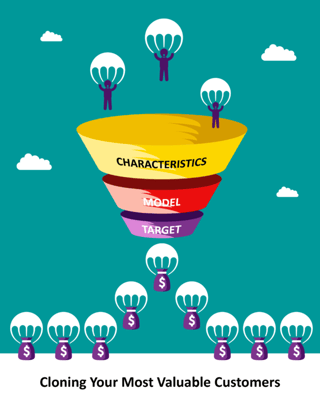Have you ever been in a meeting discussing the success of your marketing efforts and had someone say… “Great work! Now go out and get more customers that look like that.” You might scratch your head and think to yourself, if only it were that easy.
In the first two installments of our Customer Intelligence series, found here and here and video recaps found here and here, we discussed customer segmentation: how to understand which attributes of customer groups distinguish them from one another and how you can use strategic segmentation to allocate spend more effectively to gain your best return on investment. Now it’s time to discuss how to find more of your most responsive and profitable customers—and clone them.
Here are four steps to finding more of those most profitable customers through customer profiling.
![]() Step 1: Define who you want to clone
Step 1: Define who you want to clone
A clone, as defined by Oxford Dictionary, is a person or thing that appears to be an exact copy of another person. So to start, we first need to understand who we want to clone.
In order to answer this question, you need to be clear about what business problem you need to solve and how your business defines success. Business objectives can vary based upon where a business is in their growth cycle. New businesses may be less discriminate with their target market, because they know less about their customers and want to acquire as many new customers as possible. Established businesses may have access to more data and findings, so they can become more targeted in their approach—reducing their cost per acquisition and increasing their ROI.
When mining your data, you’ll discover that your customers have varying levels of Customer Lifetime Value (CLV)—the predicted net profit over the life of the customer relationship. For this discussion, let’s assume the objective is to find more of your most profitable customers.
Let’s begin with understanding what data is in your customer and prospect database. A data layout and dictionary are good places to start. These will tell you which fields or consumer characteristics you have in your data and the definitions of each. You will have PII (Personally Identifiable Information) which is unique customer information and a UID (Unique Identifier—a multi-digit number unique to each of your customers or prospects). You may have other psychographic, demographic or firmographic information. And you most likely will have some transactional information which could include responses to marketing communications, fulfillment, and/or purchasing transactions. Once you have a good understanding of what data you have and what you don’t, you should consider what additional data to append to enhance your customer and prospect profiles.
![]() Step 3: Append data and create profile(s)
Step 3: Append data and create profile(s)
Now that you know what data is in your current database, it is helpful to add your market knowledge and intuition to the equation to build hypothetical customer profiles. These hypothetical customers will help you identify what other data you may need to append to either prove or negate your hypotheses and garner the customer insights you need to be successful.
The more variety of data which defines your customers and prospects, the better chances of creating a model that will predict prospect and consumer behavior. Some examples of data elements that can be predictive are gender, age, income, marital status, presence of children, home value and buying behavior (e.g. products, seasonality, etc.). Predictive elements can be unique by industry—in the financial industry, home ownership & income/wealth-based attributes may be predictive vs. in the health insurance industry, age, marital status, and income may be more predictive. Other data considerations include competitive advantages and disadvantages within a given geographic area. For example, a service provider may have a strong benefit package or service network in one area, where a competitor may have the advantage in another geographic area. Tracking these advantages/disadvantages and the impact to results is important as well.
Once you have appended your customer and prospect data, you can build profiles of customers and prospects to determine which data variables are most discriminative. As important as it is to understand who converts (your customers), it’s equally important to understand who is responsive but does not convert, and those prospects who do not respond to your marketing interactions. Profiling these segments is also recommended and will give you additional insights for new marketing strategies to change your results.
![]() Step 4: Clone your most valuable customers
Step 4: Clone your most valuable customers
Now that you have defined your business objectives and created profiles for your customers, responders, and non-responders, it’s time to find more of the prospects that will help you meet your objectives. You can use the customer and responder profiles to segment your prospect database, or you can use the profiles as input into a modeling process which can be used to score and rank your prospects to define which segments you want to clone. The profiles you’ve created will prioritize and give weighting to different characteristics to define which is most important in identifying your best prospects. After this analysis is complete, you’ll have a clear picture of your new target audience which will help you identify—and market—to your most responsive prospects, who will become your most profitable customers.
Though data science, you can identify insights that will inform smarter marketing decisions and inspire different approaches to solving business problems. But data science can only deliver the most impactful and actionable insights when you have enough of the right data to get to statistical significance and the right analytic talent to extract those insights.
Want the most up-to-date customer intelligence tips, insights, and more? Subscribe to the Anderson blog at the top right of this page or click here.





